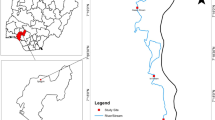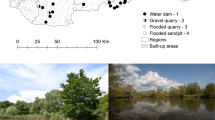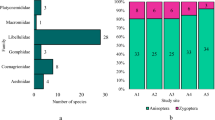Abstract
Ecologically, dragonflies and damselflies (Odonata) are good indicators of aquatic and terrestrial ecosystem. They are abundant and important members of the vicinity of inland waters. This study was carried out at Benin – Owena Basin catchment, Igbara-Oke, Nigeria. Sampling was carried out at three water bodies within the catchment of Rivers Aro, Elemo and Owena Dam. The water bodies were selected based on types of water body and prevailing anthropogenic activities around their vicinity. Sampling of specimens was randomly carried out once a month from 9am-2 pm between June, 2017 and July, 2018. Odonata naiads were collected using Kick net. Species composition, distribution and richness of the study sites were calculated using diversity indices (Shannon–wiener, Simpson, Margalef, Evenness and Equitability). Monthly collections of odonates revealed that January 2018 had the highest number of species while the least was in April 2018. Two anisopterans, Neodythemis klingi and Orthetrum julia both with 30 individuals, were the dominant odonate species. Pseudagrion kersteni (19 individuals) was the dominant zygopteran while Africallagma subtle (2 individuals) was the least represented odonate in this study. From the diversity indices analyses, Owena Dam was the richest (Shannon (H`) = 3.12, Simpson = 0.9521, Margalef = 4.42). The site was also the best in terms of distribution and spread of odonate species (Equitability = 0.9693). Similarity in odonate community structure among the 3 study sites was determined using Jaccard Coefficient (Coefficient of Community: CC), The CC analysis showed Elemo Stream and Owena Dam as the sites with similar community structure; and the diversity indices revealed Owena Dam as the richest site with the best species distribution.














Similar content being viewed by others
Change history
24 June 2022
A Correction to this paper has been published: https://doi.org/10.1007/s42690-022-00842-2
References
Adu BW, Akindele EO, Obadofin, (2015) Composition and distribution of dragonflies and damselflies (Insecta: Odonata) in Iloyin forest, Akure, southwestern Nigeria. Ethiop J Environ Stud Manag 8(5):517–529
Adu BW, Amusan BO, Oke TO (2019) Assessment of the water quality and Odonata assemblages in three water bodies in Ilara-Mokin. South-Western Nigeria. Int J Odonatol 22(2):101–114. https://doi.org/10.1080/13887890.2019.1593889
Adu BW, Ogbogu SS (2011) Diversity of dragonflies and damselflies (Odonata) in Obafemi Awolowo University. South-Western Nigeria Agrion 15(1):24–31
Akindele EO, Adedapo AM, Adu BW, Ogbogu SS (2021) First report of the larva of a vulnerable damselfly in Nigeria, with some ecological notes: A case for umbrella species conservation approach tropical conservation. Science 14:1–7
Berquier C, Orsini A, Andrei-Ruiz M (2016) Odonata Community Index – Corsica (OCIC): A new biological index based on adult odonata populations for assessment of the ecological status of watercourses in Corsica. J Ecol Indic 66:163–172
Che Salmah MR, Wahizantul Afzan A (2004) Distribution of Odonata (Insecta) in various ecosystems in northern Peninsular Malaysia. Wet Science 2:184–191
Clausnitzer V, Dijkstra KDB, Koch R, Boudot JP, Darwall WRT, Jens K, Samraoui B, Samways MJ, Simaika JP, Suhling F (2012) Focus on African freshwaters: hotspots of dragonfly diversity and conservation concern. Front Ecol Environ 10(3):129–134. https://doi.org/10.1890/110247
Corbet PS (2004) Dragonflies: behaviour and ecology of Odonata. Harley Books, Colchester
Dash MC (2003) Fundamental of Ecology, 2nd edn. Tata McGraw-Hill publishing company limited, New Delhi
Dijkstra KDB, Clausnitzer V (2014) Dragonflies and damselflies of Eastern Africa: A Handbook for all Odonata from Sudan to Zimbabwe. Stud Afrotropical Zool 298:1–264
Giugliano L, Hardersen H, Santini G (2012) Odonata communities in retrodunal ponds: a comparison of sampling methods. Int J Odonatol 15(1):13–23
Helmer R, Hespanhol I, World Health Organization (1997) Water pollution control: a guide to the use of water quality management principles. E & FN Spon. pp 459. https://apps.who.int/iris/handle/10665/41967
Issa BR, Arimoro FO, Ibrahim M, Birma GH, Fadairo EA (2011) Assessment of sediment contamination by heavy metals in River Orogodo (Agbor, Delta State, Nigeria). Curr World Environ 6(1):29–38
Koehnken L, Rintoul MS, Goichot M, Tickner D, Loftus A-C, Acreman MC (2020) Impacts of riverine sand mining on freshwater ecosystems: A review of the scientific evidence and guidance for future research. River Res Applic. https://doi.org/10.1002/rra.3586
Pilgrim EM, von Dohlen CD (2008) Phylogeny of the Sympetrinae (Odonata: Libellulidae): further evidence of the homoplasious nature of wing venation. Syst Entomol 33:159–174
Purvis A, Hector A (2000) Getting the measure of biodiversity. Nature 405:212–219
Samways MJ (2008) Dragonflies and damselflies of South Africa. Sofia and Moscow, Pensoft Publisher, p 425
Siregar A, Bakti D (2016) Diversity and Distribution of Odonata in University Sumatera Utara, Medan, Indonesia. Int J Sci Technol Res 24:229–234
Strayer DL, Dudgeon D (2010) Freshwater biodiversity conservation: recent progress and future challenges. J N Am Benthol Soc 29(1):344–358
Subramania KA (2005) Dragonflies and damselflies of Peninsular India:A field guide. Project Life scape. India Academy of Science, Bangalore, India, p 118
Suhling F, Müller O, Martens A (2014) Namibian Dragonflies: Larval Key and Distribution. Libellula Supplement 13: Bremen, 15. Zeitschrift der Gesellschaft deutschsprachiger Odonatologen (GdO) e.V. ISSN 0723-6514 5-106
Zia A, Rafi MA, Hussain Z, Naeem M (2009) Occurrence of Odonata in Northern area of Pakistan with seven new records. Halteres 1(1):48–56
Zou, W, Li, TM, Liu, L, Cai, YJ, Xu H, Peng K, Gong ZJ (2017) Macrozoobenthic community structure and water quality evaluation of Lake Luoma, Jiangsu province, China. J Lake Sci 29(5)
Acknowledgements
We want to appreciate the management of Benin-Owena River Basin Authority for granting us access to the water bodies visited in the catchment area during the course of the study.
Author information
Authors and Affiliations
Corresponding author
Ethics declarations
Ethics approval and consent to participate
Not applicable.
Competing interests
The authors declare that they have no competing interests.
Additional information
Publisher's Note
Springer Nature remains neutral with regard to jurisdictional claims in published maps and institutional affiliations.
The original online version of this article was revised due to a mismatch between the figures and their legends.
Rights and permissions
About this article
Cite this article
Adu, B.W., Ileke, K. & Olorunmeke, O.A. A preliminary study of biodiversity and biomonitoring potential of Odonates of Benin-Owena River Basin catchment, Igbara-Oke, Ondo State, Nigeria. Int J Trop Insect Sci 42, 2853–2864 (2022). https://doi.org/10.1007/s42690-022-00803-9
Received:
Accepted:
Published:
Issue Date:
DOI: https://doi.org/10.1007/s42690-022-00803-9




